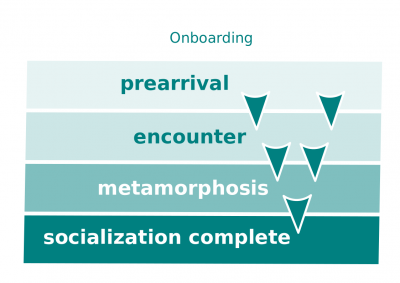Difference between revisions of "Onboarding"
(→Related lectures) |
|||
| Line 20: | Line 20: | ||
==Related lectures== | ==Related lectures== | ||
| − | |||
*[[Market Engagements Quarter]]. | *[[Market Engagements Quarter]]. | ||
| + | *[[What Recruitment Is]]. | ||
| − | [[Category: | + | [[Category: CNM Cyber Orientation]][[Category: Septem Artes Administrativi]][[Category: Articles]] |
Revision as of 21:19, 24 May 2020
Onboarding (hereinafter, the Process) is the process and/or the learning sequence that depicts that process of either:
- Integrating a new employee into an organization including helping this employee to adapt to the organization's culture (this process is more specifically known as organizational socialization, socialization process, or, simply, socialization); or
- Familiarizing a new customer or client with one's products or services.
Definitions
According to Organizational Behavior by Robbins and Judge (17th edition),
- Socialization. A process that adapts employees to the organization's culture.
Socialization process
Socialization is the Process through which:
- A new employee acquires the necessary competence and credentials in order to become a productive organizational member and insider. This process is also known as organizational socialization, socialization process, or, simply, socialization;
- An employer settles a new employee in a particular position.
Onboarding can also described as the mechanism of integrating a new employee into the enterprise and its culture.
Stages
- Prearrival stage. The period of learning in the socialization process that occurs before a new employee joins the organization.
- Encounter stage. The stage in the socialization process in which a new employee sees what the organization is really like and confronts the possibility that expectations and reality may diverge.
- Metamorphosis stage. The stage in the socialization process in which a new employee changes and adjusts to the job, work group, and organization.
